
 |
ESPAÑOL |
| HOME | ECOAMIGOS DE MULEGÉ | ISSI | NATURAL HISTORY | CONSERVATION | BAJA PLANTS | GALLERIES | LINKS | ABOUT |
| Trail and Plant Guide: Mesa del Rincón San Ignacio, BCS | |
| Guide Main | Trail Descriptions | Trail Map | Plant List TRAILS: El Camino Real | La Vista del Cañon | La Virgen de Guadalupe | Los Corralitos | El Atajo | El Malpaisal | El Arrecife |
|
Trail Descriptions |
|
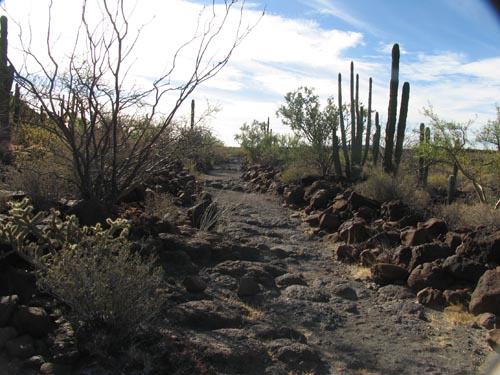 |
El Camino Real [½ mi. - 750 m] N 27.2788°/ W 112.8957° The trail begins along a low rock wall (1*), turns and then climbs gradually up less than a hundred feet to the mesa through cuts in the foundation rock. Near the base (2), the wide trail passes through a layer of caliche (limestone with embedded fossilized shells) capped with lava. At the top of the climb (3), the stone steps and path have been hewn out of the lava flow. A basalt block named Cerro Tepayac rises above the trail on the east side, with talus slopes below. Look for Turkey Vultures roosting high up on the rocks along the ridge. From here, to the northwest is a vista of the town of San Ignacio. Click here to see what plants can be found along this trail. |
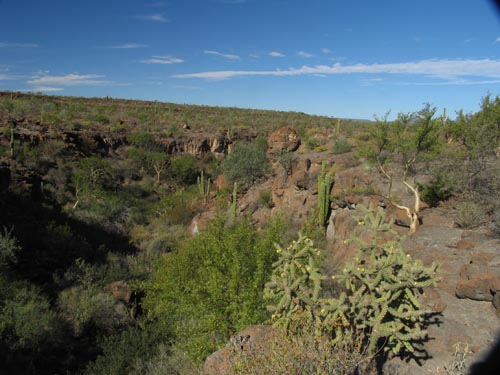 |
Vista del Cañon [50-75 yds/m] N 27.2754°/ W 112.8949° This short spur trail will take you through volcanic rubble and natural cactus gardens to the edge of the mesa. The Vista point (6) is an open slab of rock affording a view across the narrow canyon to a rock terrace on the opposite side as well as of the canyon floor. For the sure-of-foot, it is possible to continue past the vista point, walk across lava boulders and follow the wide arroyo about 75 yds/m to meet the Los Corralitos trail at Marker 9. Click here to see what plants can be found along this trail. |
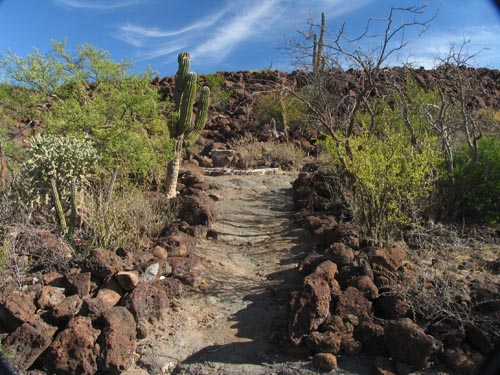 |
Virgen de Guadalupe [50 yds/m] N 27.2739°/ W 112.8939° This is a short side trail to an altar site at the base of the Cerro Tepayac talus slope. Click here to see what plants can be found along this trail. |
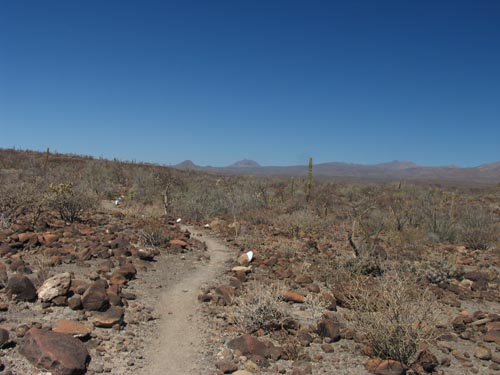
|
Los Corralitos [0.6 miles - 1 km] N 27.2726°/ W 112.8937° This trail crosses a fairly flat, volcanic debris field with lots of open ground. The trail is narrow in places, but well marked with an occasional rock painted white. It meanders across the mesa from east to northwest. Shortly after it branches off from the Camino Real trail at #8 (where there is a rock cairn painted white), it passes through a lava flow (9). On either side of the trail at this point, look for the tinajas (pools) carved into the rock by water action. Head north along the flow to see the larger pools. El Atajo trail runs into Los Corralitos from the north at Marker 10. There, at the distinct Y in the trail, continue along Los Corralitos by taking the left fork. The trail is named for its corralito (12),an open-air, rock ring campsite created by the nomadic, indigenous people of the area. Please don’t disturb this archeological structure. A short distance beyond, there is a spur trail (13) to another vista point on the north edge of the mesa. The trail meanders across the mesa and a cairn (14) marks the beginning of El Malpaisal trail that continues northwest towards El Rincón (the Corner), another Vista Point (18) and El Arrecife trail (17). From this same cairn, an old cattle trail continues southward for many miles. Click here to see what plants can be found along this trail. |
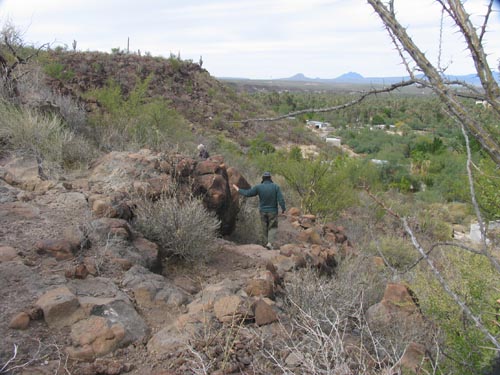 |
El Atajo [130 yds/m] N 27.2774° / W 112.8964° This shortcut (atajo in Spanish) is a quick, switchback climb up or down from Los Corralitos trail. The trail begins at Marker 21* with a mound of white rocks. There are a number of interesting rock formations in the bedrock of the trail, including a large “cow-pie bomb”, created when a large lump of molten lava was ejected and splatted on the ground, cracking in a circular pattern as it cooled. The ascent/descent is short and steep with loose rocks and gravel and may prove difficult for some. Click here to see what plants can be found along this trail. |
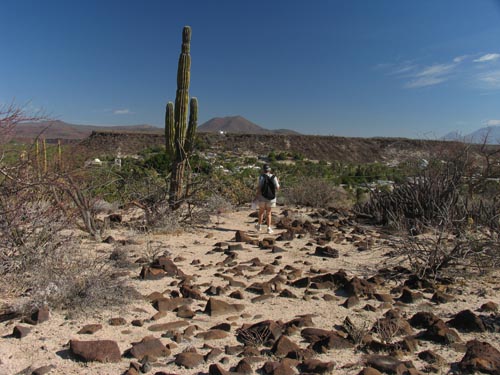 |
El Malpaisal [¼ mile - 750 m] N 27.2783°/ W 112.8994° This is rougher than the Los Corralitos trail because of the volcanic rocks strewn across the trail. Malpaisal refers to this type of rocky, tumbled terrain. The trail twists and turns a short distance. After an open, sandy area with robust vegetation (16), the path meets El Arrecife trail (17), and continues on to a lovely vista point (18) with a sweeping view of the town and palm orchards. The area’s volcanos are also visible from here—can you imagine the steam belching from their peaks in the not so distant past? Click here to see what plants can be found along this trail. |
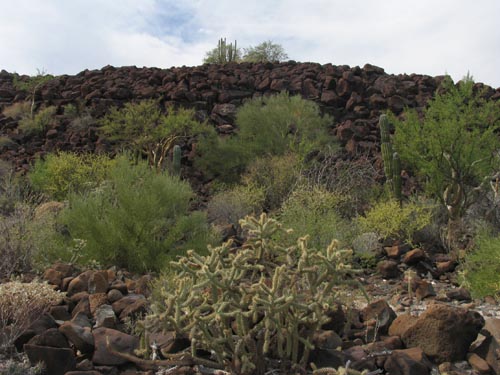 |
El Arrecife [150 yds/m] N 27.2788°/ W 112.9007° This short side trail, with about a 30 ft (10 m) elevation gain is rough going up through a talus slope, but the trip is well worth it, since there are some plants that are rarely seen on the lower part of the mesa. Look for the white rock cairn at the beginning of the trail (17). Follow the white, painted rocks up through several levels of large lava boulders to a flatter area (19). There is an open area at the end of the trail appropriate for camping (20). The plants on the arrecife (reef) include an endemic Baja agave and very large specimens of two species of barrel cactus. The rocks forming the talus are lava “blocks” or “clinkers” and many make a wonderful, metallic sound when whacked with another rock. The trail currently ends at Marker 20, but there is still a lot to explore. Head west from #20 to reach the mesa’s edge. Click here to see what plants can be found along this trail. |
| Note on Trail Lengths: Distances are approximate for each trail segment.
Conversion between English and metric distances has been rounded, so some distances may not be a true equivalent.
Approximate Trip Lengths: One way trips: |
|
| All text, images and files are copyrighted © 2009 by LasEcomujeres.com unless otherwise credited. To obtain permission for personal, academic, commercial, or other uses, or to inquire about high resolution images, prints, fees, or licensing, or if you have other questions, contact: info@lasecomujeres.org The thumbnail photos on this page may be freely used for personal or academic purposes without prior permission under the Fair Use provisions of US copyright law as long as the photo is clearly credited with Copyright © 2009 LasEcomujeres.com For other uses, contact us. |
| info@lasecomujeres.org |
| 21-Mar-2012 |